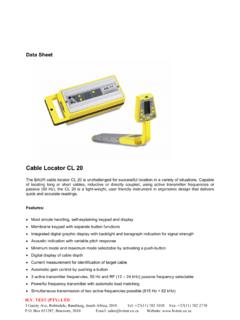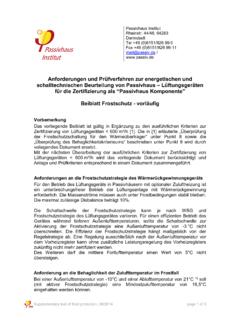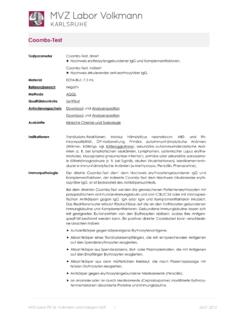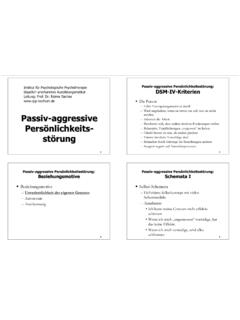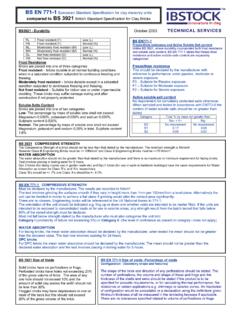Transcription of Guidelines for Blower Door Testing - Greenbuild
1 Passive House Blower Door Testing Guidelines Guidelines for Blower Door Testing of Passive Houses Greenbuild 1. Passive House Blower Door Testing Guidelines Table of Contents 4. 5. Reasons for 5. Follow German practices to eliminate doubt?.. 6. Reason for Passive House to have its own Test Protocol Extension to About the 7. Blower door Testing 8. Why EN13829?.. 8. Overview of 9. Acceptable Test 9. Test Preparation 9. Test 10. 10. Additional Notes on Door Fan set 11. Some items to note if Testing to EN9972 12. Testing one unit within a Multi- Unit 14. Passive House - Volume 15. Airchanges per 15. Internal Air 15. Passive House 16. Who Calculates the Volume?.. 17. The q50 and Larger 17. Leakage 18. Appendix A : EN13829 Method A 20. Appendix B : Volumes allowable in the Passive House Blower Door Greenbuild 2. Passive House Blower Door Testing Guidelines Document version: Date: 09/02/2018. Author: Gavin S , Greenbuild , Inch, Gorey, Co.
2 Wexford, Ireland Change History:10 August 2011 original document 07 September 2011 added section on Blower door fan set up 07 September 2011 added section on treatment of window/door reveals 03 April 2012 alterations to align document to newly uploaded Passipedia document main changes were addition of q50 section for larger buildings, sealing of HRV systems before a test, volume of stairwells 31 August 2012 added section on multi-unit Testing (guarded zone Testing ). 10 September 2013 altered section on attic volume calculations, ref: Mosart & Soeren Peper PHI. 07 July 2015 edits and corrections -thanks to Colm h onghusa for some pointers; added tracer gas method for leak detection thanks to Katariina Laine. 9 February 2018 updates to make reference to the EN 9972:2015 that has replaced EN 13829:2000 for most Testing in European countries. Links to passipedia article updated. Small edit to the q50 requirement for larger buildings.
3 2011, 2012, 2013, 2015, 2018 Gavin S , Greenbuild for all pictures and text. This document may be freely copied and distributed provided that acknowledgement is given as to the source. Any errors or omissions are unintentional but are the responsibility of Gavin S and not any other named references. Greenbuild 3. Passive House Blower Door Testing Guidelines Introduction The Passive House standard is now widely accepted as a viable framework for the specification and building of very low energy and comfortable buildings. The standard calls for high performing building envelopes, with excellent insulation, low thermal bridging rates and and low air leakage rates, as well as emphasis on ventilation and building orientation. The low air leakage rates that are required in the standard must be proven for each individual building by means of a Blower door air tightness test. The air change rate must be below airchanges per hour under test conditions.
4 This document seeks to provide clearer guidance on the Blower door test as it pertains to the Passive House standard, and it is aimed mainly at Blower door testers, specifiers, engineers and architects involved in the Passive House process, although of course it may also prove useful to others involved in Passive Houses. After the first versions of this document were written, the Passive House Institute posted in March 2012 a more concise and relevant article than they ever had before on Passive House airtightness. The current version of this document is found at the link address below (Feb. 2018): Although that article and this document cover a lot of the same ground, we will maintain this document to provide some further guidance and reasoning for the target audience. In the case where for any reason this document and the Passipedia article do not concur, the Passipedia document should evidently be taken to have priority.
5 A login may be need to access the content of that document. Greenbuild 4. Passive House Blower Door Testing Guidelines Background When undertaking U Value calculations for the Passive House, there is a sheet in the PHPP that directs the process, so that it is done the same across all projects (or should be!). When specifying technical components, such as ventilation systems or windows for example, the Passive House Institute itself can issue certificates for the components to prove the component's efficiency. Test certificates from other reputable laboratories who test to the correct standard can be also taken, albeit with a reduction factor in some cases. Thus, these details can be understood as relatively well comparable across projects. For the Blower door test, it is specified that the test must be undertaken to EN13829 Method A, and that the Blower door reference volume, called Vn50 in the PHPP, is the full internal air volume of the building under test.
6 So far, it seems clear. However, many testers, architects, builders and specifiers find that there is still much room for doubt as to whether the test has been performed correctly, and if the result has been related to the correct building volume to determine the air change rate. Also, as from 2015, European countries have gradually adopted EN 9972:2015 as an update and replacement to the EN13829 standard. Although the content of the two standards is close, there are a number of differences that might affect the understanding of the test results. For most of this document, we will continue to reference the EN13829:2000 standard as the main standard to be adhered to, but with a little extra section at the end for the things to watch out for if Testing to EN9972:2015. Reasons for There are two main reasons for doubt to creep in as to the validity of the Blower door test results for the Passive House: 1. The EN13829 standard is not implemented the same in different countries.
7 Thus, even though Method A and n50 are specified by the Passive House Institute as being the Method required and the result reporting unit required for the standard, testers in different countries may approach Blower door Testing of the Passive House as they do the Testing of houses for their national regulations. 2. There is no oversight or regulatory body in most countries to ensure that tests are performed the same by all testers. In most countries this is the case even for the national regulations, it is therefore even more so for the Passive house movement, which is purely voluntary. And even where this regulation might apply, the Passive House requirement of Method A and the volume calculation may not match national methodologies. For example, 2 preparation methods are described in the EN13829, simply called Methods A and B;. there are also 3 reporting units given the terminology w50, q50 and n50, the extent of each of these can be reported on differently in different countries.
8 So it is that there is the danger, where even using the same preparation method, lets say, Method A, and the same reporting unit, say n50, that airtightness testers will find that if they compare notes with Greenbuild 5. Passive House Blower Door Testing Guidelines colleagues in their own countries and in other countries, whilst everyone will feel they are working to the correct standards, they are in fact not all following the same test preparation or unit calculation procedures. From speaking to testers in various countries, where there is no regulatory overseeing body or voluntary Testing association, it will be found that even the nationally stipulated methods and reporting units are not all understood the same by all testers. We would suggest this is even more so for the Passive House requirements, which are still a novelty in many areas. Also, for Passive House projects outside of Europe most testers involved in Passive House projects would have no familiarity at all of the EN13829 standard.
9 Follow German practices to eliminate doubt? As the Passive House standard originated mainly in Germany, and all the early Testing would have been in that country, then one would think that following the EN13829 practices as they are understood in Germany would lead to a fully acceptable and dispute free protocol for Testing . However, it will be found that even among testers in Germany, there is disagreement on items requiring sealing or on the volume calculations. Also in Germany, where many testers have been always Testing to Method A, the national test preparation method to satisfy the building regulations has more recently been specifically stipulated as Method B. Therefore, we cannot reliably depend on following German practice alone in this regard, and we would argue that the Passive House Institute needs to either: a) describe a test protocol in its entirety so that everyone follow the same procedure across the world, or b) allow in the PHPP calculations some kind of discrepancy amount in Blower test results, to allow for the fact that tests may be 5-10-maybe even 15% different across jurisdictions and even within jurisdictions, depending on how the testers understand the EN13829 regulation and the Passive house internal volume calculation.
10 Reason for Passive House to have its own Test Protocol Extension to EN13829. Following on from item a) above, Greenbuild is submitting this document as a starting point for discussion. It may be that the PHI decides to follow option b) above, or indeed another option not though of here. Based on option a) above: To allow tests to be properly compared across the world, and to be sure that the Passive House criteria is actually being fulfilled, it is important that everyone who is Testing and specifying and building Passive Houses are all working to the same standard and assumptions, as it is with the U Value calculations and technical component performance certificates. Thus this brief guide. We will look at the EN13829 standard to which the tests should be performed, with guidance given for items not specifically covered by the standard. We also very importantly give guidance on how the volume is calculated according to the Passive House standard.
